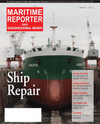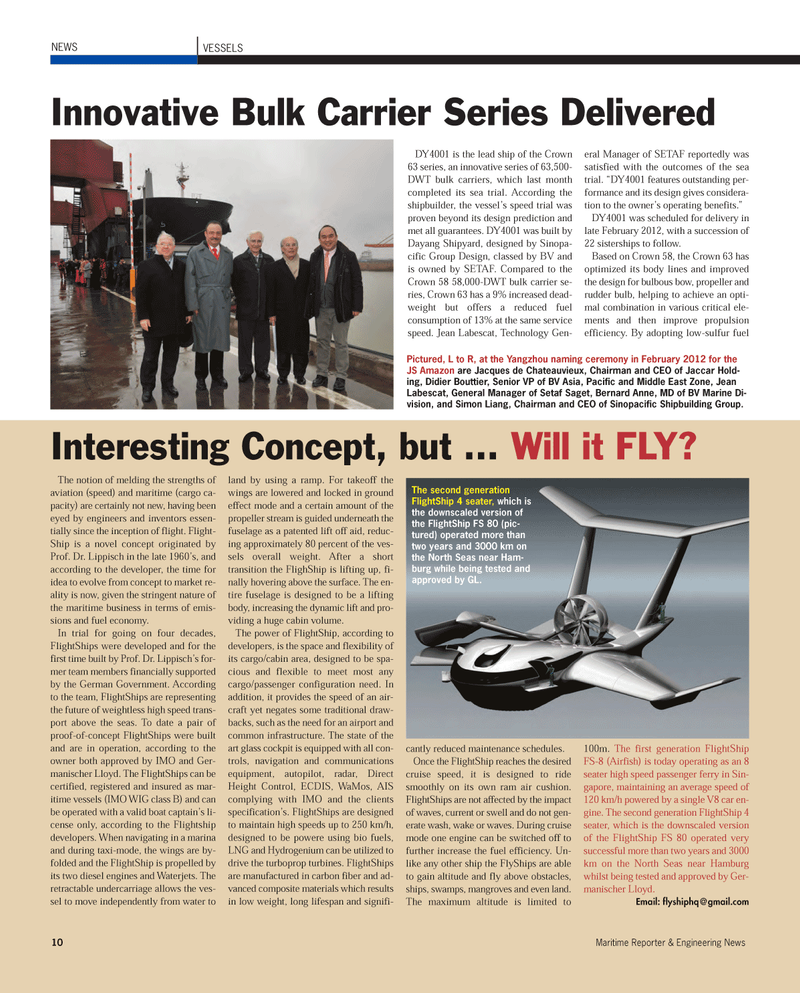
Page 10: of Maritime Reporter Magazine (March 2012)
The Ship Repair Edition
Read this page in Pdf, Flash or Html5 edition of March 2012 Maritime Reporter Magazine
The notion of melding the strengths ofaviation (speed) and maritime (cargo ca- pacity) are certainly not new, having been eyed by engineers and inventors essen- tially since the inception of flight. Flight-Ship is a novel concept originated by Prof. Dr. Lippisch in the late 1960?s, and according to the developer, the time for idea to evolve from concept to market re- ality is now, given the stringent nature of the maritime business in terms of emis- sions and fuel economy. In trial for going on four decades,FlightShips were developed and for the first time built by Prof. Dr. Lippisch?s for- mer team members financially supported by the German Government. According to the team, FlightShips are representingthe future of weightless high speed trans-port above the seas. To date a pair of proof-of-concept FlightShips were built and are in operation, according to theowner both approved by IMO and Ger- manischer Lloyd. The FlightShips can be certified, registered and insured as mar- itime vessels (IMO WIG class B) and can be operated with a valid boat captain?s li- cense only, according to the Flightship developers. When navigating in a marina and during taxi-mode, the wings are by-folded and the FlightShip is propelled byits two diesel engines and Waterjets. The retractable undercarriage allows the ves- sel to move independently from water to land by using a ramp. For takeoff the wings are lowered and locked in ground effect mode and a certain amount of the propeller stream is guided underneath thefuselage as a patented lift off aid, reduc- ing approximately 80 percent of the ves- sels overall weight. After a short transition the FlighShip is lifting up, fi- nally hovering above the surface. The en- tire fuselage is designed to be a liftingbody, increasing the dynamic lift and pro- viding a huge cabin volume. The power of FlightShip, according to developers, is the space and flexibility of its cargo/cabin area, designed to be spa- cious and flexible to meet most any cargo/passenger configuration need. In addition, it provides the speed of an air- craft yet negates some traditional draw- backs, such as the need for an airport andcommon infrastructure. The state of the art glass cockpit is equipped with all con-trols, navigation and communications equipment, autopilot, radar, Direct Height Control, ECDIS, WaMos, AIS complying with IMO and the clientsspecification?s. FlightShips are designed to maintain high speeds up to 250 km/h,designed to be powere using bio fuels, LNG and Hydrogenium can be utilized todrive the turboprop turbines. FlightShips are manufactured in carbon fiber and ad- vanced composite materials which results in low weight, long lifespan and signifi- cantly reduced maintenance schedules.Once the FlightShip reaches the desiredcruise speed, it is designed to ridesmoothly on its own ram air cushion. FlightShips are not affected by the impact of waves, current or swell and do not gen- erate wash, wake or waves. During cruise mode one engine can be switched off to further increase the fuel efficiency. Un- like any other ship the FlyShips are able to gain altitude and fly above obstacles, ships, swamps, mangroves and even land. The maximum altitude is limited to100m. The first generation FlightShip FS-8 (Airfish) is today operating as an 8 seater high speed passenger ferry in Sin-gapore, maintaining an average speed of 120 km/h powered by a single V8 car en- gine. The second generation FlightShip 4 seater, which is the downscaled version of the FlightShip FS 80 operated very successful more than two years and 3000 km on the North Seas near Hamburg whilst being tested and approved by Ger- manischer Lloyd. Email: [email protected] Reporter & Engineering News NEWSVESSELSInteresting Concept, but ... Will it FLY? The second generationFlightShip 4 seater, which isthe downscaled version ofthe FlightShip FS 80 (pic-tured) operated more than two years and 3000 km onthe North Seas near Ham- burg while being tested and approved by GL. Innovative Bulk Carrier Series Delivered DY4001 is the lead ship of the Crown 63 series, an innovative series of 63,500- DWT bulk carriers, which last month completed its sea trial. According the shipbuilder, the vessel?s speed trial was proven beyond its design prediction and met all guarantees. DY4001 was built by Dayang Shipyard, designed by Sinopa- cific Group Design, classed by BV and is owned by SETAF. Compared to the Crown 58 58,000-DWT bulk carrier se- ries, Crown 63 has a 9% increased dead- weight but offers a reduced fuel consumption of 13% at the same servicespeed. Jean Labescat, Technology Gen- eral Manager of SETAF reportedly was satisfied with the outcomes of the sea trial. ?DY4001 features outstanding per- formance and its design gives considera- tion to the owner?s operating benefits.? DY4001 was scheduled for delivery in late February 2012, with a succession of22 sisterships to follow. Based on Crown 58, the Crown 63 has optimized its body lines and improved the design for bulbous bow, propeller and rudder bulb, helping to achieve an opti- mal combination in various critical ele- ments and then improve propulsion efficiency. By adopting low-sulfur fuel Pictured, L to R, at the Yangzhou naming ceremony in February 2012 for the JS Amazonare Jacques de Chateauvieux, Chairman and CEO of Jaccar Hold- ing, Didier Bouttier, Senior VP of BV Asia, Pacific and Middle East Zone, Jean Labescat, General Manager of Setaf Saget, Bernard Anne, MD of BV Marine Di- vision, and Simon Liang, Chairman and CEO of Sinopacific Shipbuilding Group. MR March 12 # 2 (9-16):MR Template 3/5/2012 9:06 AM Page 10

 9
9

 11
11
